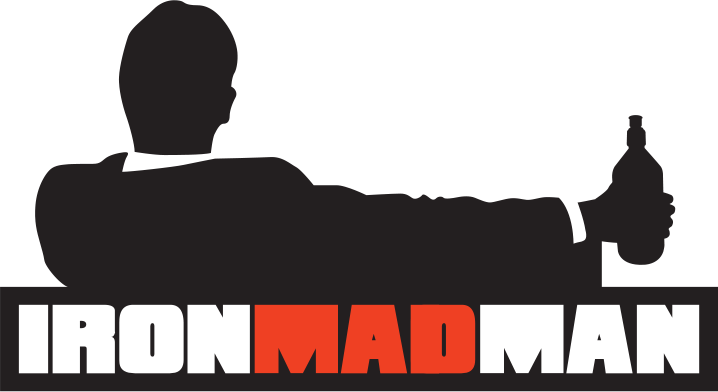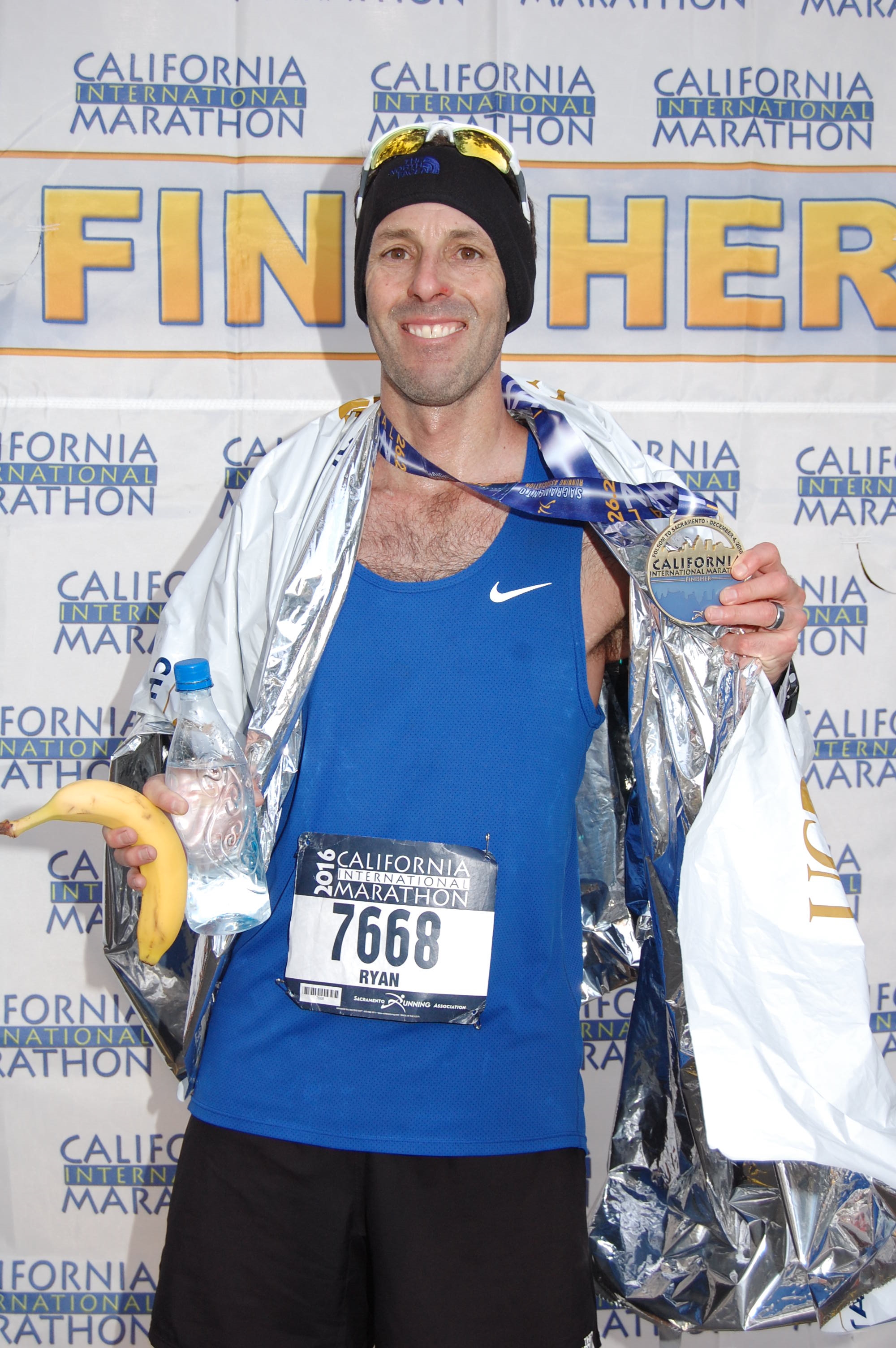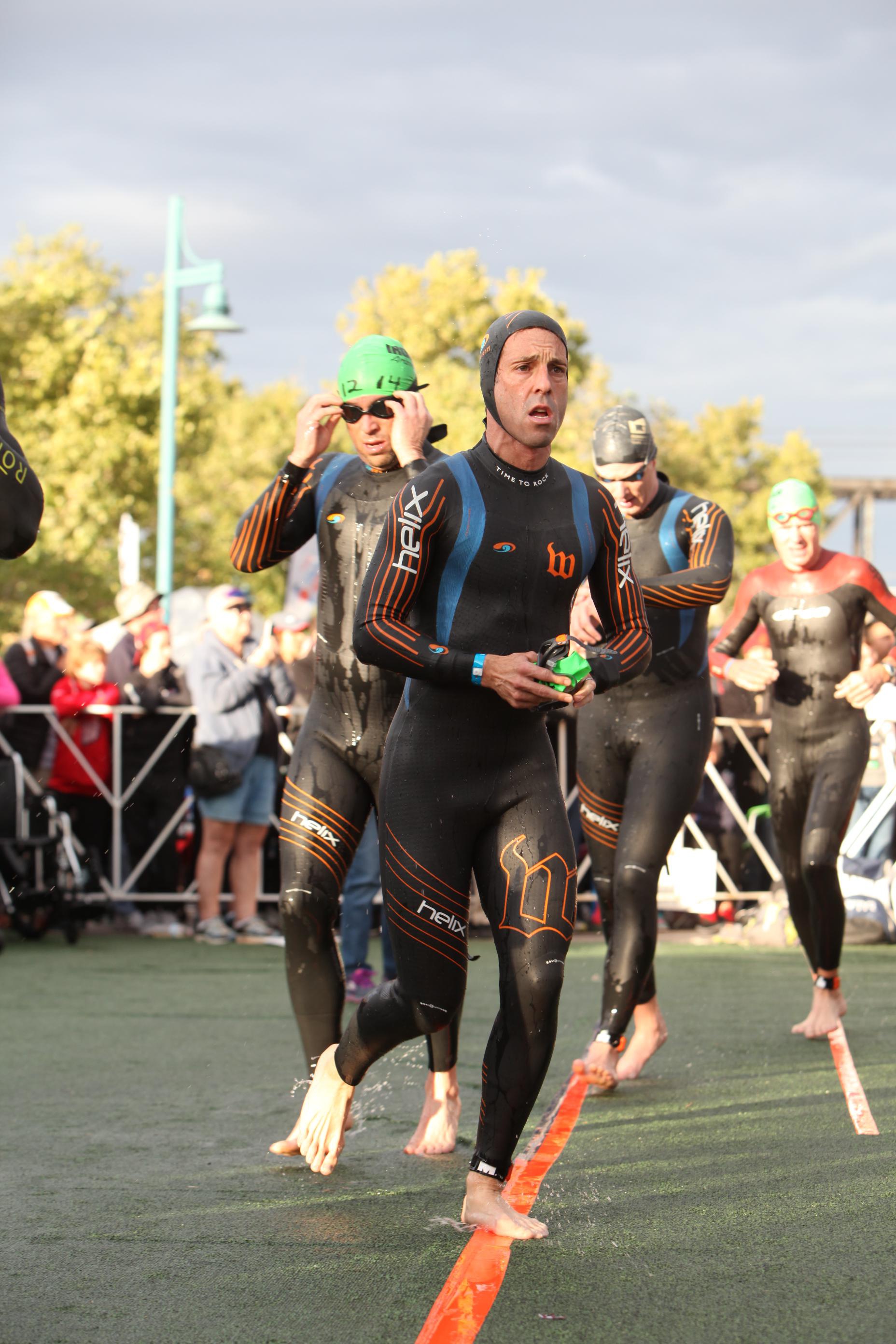CIM Race Report Part II: The Marathon of Recaps Continues
/Training for an endurance race is kind of like parenting an infant. You show up, day in and day out. Workout after workout. Rain or sunshine. The reward? Nothing discernible for weeks...or months. That smile you think you saw on your baby's face directed just for you? That was probably gas. You begin to wonder whether you're making a difference. Then, seemingly out of nowhere, you notice a subtle change. You're seeing responses, adaptations. Growth. And then it's back to prolonged periods of what seems to be...nothing. Just the monotony of the day-to-day grind. "Will this child ever love me?!" I've definitely had those frustrating thoughts many times the last 18 months with Audra. Similarly, I wondered after months of slow, easy runs nowhere near a Boston Marathon-qualifying time, "How in the heck am I going to run 60-90 seconds faster for 26 freaking miles?!"
This past weekend at the California International Marathon, all the consistent, unglamorous training paid off. Not only did I hit my goal pace for 26.2 miles, I beat it. Of course, my marathon wound up being *26.3* miles, but that's the story you already know from yesterday's post.
This entry is for runners of all types trying to grow in their own way, whether you're running your first 5k, considering a Boston Marathon qualification attempt, or a seasoned elite runner already.
Here's a look at what I think worked and didn't work so well in my first BQ attempt.
WHAT WORKED
Training Regimen: After researching a few options, I purchased a personalized marathon plan from MacMillan Running. I had a few people I trust review the plan, and they agreed it was on point. The occasional email check-ins by assistant coach and Olympic athlete Andrew Lemoncello exceeded my expectations. This wasn't a cookie-cutter plan devoid of personal attention. Combined with the strategic approach, accessible workouts and positive reinforcement, I would recommend a MacMillan personalized plan for people not seeking hands-on daily coaching but rather a plan to guide their training.
I do prefer more frequent interaction though when I'm seriously training for a race. When I learned that longtime friend, Wattie Ink teammate and mentor-figure Dusty Nabor was entering the coaching ranks at Accelerate 3 with my 2015 Ironman Arizona coach Brian Stover, I eagerly signed aboard. Dusty and I both have been heavily influenced by Brian's training approach, so the coach-athlete fit is natural. Plus, Dusty knows my tendencies and is local...he'll help protect me from myself! Tying it all together, the MacMillan program reflected our general collective approach of high-volume, low-intensity training. This allows for more training, better recovery and a gradual increase in vascular-muscular-aerobic capacity. Optimal training.
But what exactly was in the plan? Most of it called for easy, aerobic-paced runs -- literally four out of every five sessions at least. These were the same kinds of runs I did ad nausea preparing for Ironman Arizona with Brian last year. Guess what though? They work. Sure, I did some speed work typically once a week and as the race drew closer there were at least four 18-20-plus mile runs that included some tempo pacing. But overall, steady volume at a conversational pace was the typical daily workout. My biggest issue was staying slow and easy, not going harder or faster.
So if you see workouts like 3x10-20-minutes at tempo or threshold pace routinely during your coached marathon training...well, good luck with that. I've been there before, and it's counter-productive.
Race Day Nutrition: Race week approached, and confidence in my training allowed me to free up mind space to think about other important race day issues like nutrition. I consulted Brian and Dusty for their thoughts and created my own plan based on their input about a basic caloric threshold I'd need to hit to maintain energy from start to finish.
I think we nailed it. We figured I'd burn at least 2,500-3,000 calories over the course of the marathon, and I did. To put back roughly half of those calories into my system, I ate a bowl of oatmeal with almonds and raisins, half a peanut butter sandwich on cinnamon-raisin bread, and a banana roughly two hours prior to the race. During the race, I consumed five Gu Roctane gels (5x100 cal.), a Honey Stinger packet of chews (160 cal.) and 18 ounces of Fluid Performance (~150 cal.). I lost one Gu gel packet early in the race and wished I hadn't, but still believe I ate and drank enough throughout the morning. My pacing was almost perfectly consistent and I never felt like I hit a mental wall -- especially in the spots I typically do during an Ironman marathon (miles 13-15 and miles 18-23). Nor did I have any issue with getting the food and drink to stay down. Better still, I hardly experienced any cramp-like moments, outside of a brief twinge in my right hamstring very late in the race and some abdominal tightness within the last two miles. I attribute that good fortune at least partially to the Sport Legs pills I take prior to races and long training runs.
Pacing: This took a giant leap of faith. I really had no idea whether I could maintain a 7:19-7:21 overall marathon pace, though Dusty, Brian and my friends who have qualified for Boston assured me otherwise. I chose to listen to them and absorb their good vibes.
Prior to race day, I bought a pace sheet from MyMarathonPace.com for a nominal price (thanks to Jason Weilert for the tip). You pick the race, enter some predictions about goal pace, fast or slow start, how much you expect to fade towards the end, and negative or positive split. You then receive customized data for mile splits further influenced by the course elevation profile. Then you can print it to create a DYI wristband. I planed to use the wristband as a specific target as much as possible. I knew it would serve as a fun mental distraction and tap into my videogames sensibilities. I pictured racing games with time bonuses for each mile I completed, including 8-bit music sounds for perfect pacing.
How'd I do? Here are the race-recorded milestone paces shown on the results page:
-- 10k: 7:21/mi
-- 13.1 miles: 7:21/mi
-- 20 miles: 7:21/mi
-- Finish: 7:23/mi
As each split came in, my friend Sebastian Kouladjian exclaimed to my family and friends following along digitally, "He's the Human Metronome!"
Yesterday, I noted my watch showed I was actually faster than these pace markers. And honestly, I wasn't trying to maintain 7:21 overall as much as I was trying to match and manage every single mile. To that end, I only hit the exact mile split once (7:20 at mile 19), but came within three seconds either way for 18 total miles, and was faster by more than three seconds for all but two of the other miles. Better still, I was faster than my pace predictor from miles 21 practically through the end of the race, except for being one second slower in mile 25.
I attribute my successful pacing to proper nutrition keeping me mentally strong enough to remain focused throughout the race. It's easy to get distracted when you're surrounded by enthusiastic spectators, hordes of runners, and pace leaders yelling out every mile or so. Through that ruckus, I was able to remain calm and stay within myself, even letting the 3:13:00 pace group leaders go during various parts of the race when their pace didn't feel right to me.
This is around mile 21-22, and I'm just ahead of the 3:13:00 pace group, a spot I had claimed for about half the race...until they slipped away at the end.
Course: The CIM course is billed as the fastest for BQs in the western United States, possibly in the entire country. Almost every mile is net-downhill.
But that doesn't mean the race is flat! Far from it. My friend Jason warned me at dinner a few times prior to the race that the CIM course "undulates." He added that there really aren't many roads locally that truly emulate the course either. I would now agree. Every mile through 21-22 features at least one fairly significant rise in the terrain that felt like it lasted between five to 15 seconds. Taken individually, these tiny ankle-biters are inconsequential. But your body will beg to differ late in the race, especially near the bridge around mile 21-22. Pacing the race correctly becomes that much more important. It would be all too easy to go out and blast the first 10k to 13 miles but I think you'll regret it.
The best example I can come up with to help you visualize the undulations would be portions of Pearblossom Highway (California State Route 138), that lonely narrow road connecting Antelope Valley to Victorville on the way to Las Vegas. If you've driven it before, you know there are long, flat stretches punctuated by small but noticeable rollers. CIM's rollers are even less pronounced than Pearblossom though. Another example might be some of the smaller hills on Zoo Drive at Griffith Park near Travel Town (not Trash Truck Hill!), and the rolling hills on Griffith Park Road heading towards Los Feliz Boulevard. The rollers there are more exaggerated than at CIM though, and the distance between rollers is greater at CIM. You get the idea though, CIM isn't an all-out downhill sprint course.
The weather was just about perfect. The race started in the low 40s and finished in the low-mid 50s, with perfect sunshine and no wind (I got a slight sunburn, in fact). You can see in the images I didn't have to bundle up, and I'm a notorious weather wuss. The other great thing about the course is how well spectated it is. I can't remember one section of the entire race that was completely devoid of residents cheering runners on. That became especially important later in the race.
Pre-Race Routine: I traveled to Sacramento alone the day before the race, and outside of my friends Kayla and Alison, I didn't know anyone racing. I kept to myself in my hotel, (Sheraton Grand Sacramento Hotel) situated literally across the street from the CIM expo and a bus departure for the race start in Folsom. Following packet pickup on Saturday and a quick visit with Kyla, I didn't leave my room from around noon Saturday until 5 a.m. on race day. Toes up! I controlled all my meals without worrying about pleasing other racers or family. Speaking of, Paesanos will fill amply fill your carb-loading Italian food needs.
There's so much to be said for not needing to drop off multiple Ironman pre-race bags, a bike and thinking about a pre-race wetsuit swim. Having so much free to myself felt truly luxurious, and I know that mental and physical opportunity to unwind contributed to my race performance.
Following the race, I just had to walk about three blocks from the State Capitol back to the hotel. The walking actually felt good to stay moving, despite the soreness and my shivering. And if you want to fly back to Burbank same-day, the 2:55 p.m. flight on Southwest Airlines is ample if you're speedy. I took the 4:30 p.m. flight home and hung out in the airport for an hour.
This is what happens when you travel alone to a race.
WHAT DIDN'T WORK
Poor Boston Prep: I'm likely going to miss the 2018 Boston Marathon cut-off time not necessarily because I wasn't fast enough -- though technically that is the case. I'm probably going to miss the 2018 Boston Marathon cut-off time because of ignorance. While I knew there was a difference between a qualifying time and the age-group cut-off time, I was under the impression that an approximate two-minute gap would guarantee first-week acceptance into the race. Heck, why would the CIM pace groups be "3:13:00" and not "3:15:00", or "3:37:00" and not "3:40:00"? So obviously that is not the case. In 2016, my age-group cut-off was 3:12:32. Had I simply researched this in advance, I would have entered "3:11:30" as my desired finish time in my marathon pace calculator spreadsheet. This is an inexcusable error on my part, and completely avoidable.
If you are contemplating a Boston Marathon qualification attempt, do your homework! Leave extra room for unexpected added distance covered too.
Missed the Decisive Final Kick: There's a larger issue here first. And that is: If you're going to even partially rely on pace leaders at a marathon, try to speak with them in advance to understand how they're going to pace the group. Will they be consistent from start to finish? Start slow and build steam? Are they planning to kick hard at the end? When? I looked up the Strava performance for one of the 3:13:00 pace group leaders. While his overall pace was 7:21, this leader's last two miles were his fastest of the entire race. In fact, during miles 17-24, the pace leaders were running just at or slightly slower than BQ pace and then dropped to 7:15-7:16 the last two miles. I wasn't quite prepared for that, it was already hard enough just to stay close to BQ pace.
As you can see in the image further above in the pacing section, I'm running ahead of the 3:13:00 pace group at around mile 21. I had been in this position mostly from mile 10 onward, until mile 24 when the leaders took off. Because I had been bouncing back and forth with the pace group for most of the race, I didn't think much when they surged forward. I only realized what was happening when they put a significant gap on me around the onset of mile 25. By then it was too late. I had slowed down to a 7:30 pace while they were speeding up.
Yep, that's caked on blood from my opposite ankle. you ain't got nothin' on me, schilling!
Poor Body Mechanics: See that crimson smudge on the inside of my left shoe? That's blood. My blood...from my inside right ankle. My left leg is collapsing inward, swiping my ankle enough to rub it raw and cause it to bleed down into my sock, like Curt Schilling. It's likely a hip issue, complicated by an uneven pelvic girdle. My left hip dips slightly and my right hip is raised. Further, I had been facing some Achilles complications in my left heel the last few weeks. My heel and lower calf felt tight enough to where I eased back a critical training week with about three weeks left before the race. Fortunately, my longtime massage therapist Efren Jimenez helped me work through the Achilles issue with electronic stimulation work and some deep tissue massage. He also recommended kinesio tape for the race. I knew Dusty was dead set against this. After doing some research on my own, I concluded that the tape wouldn't likely help me. But it wouldn't hurt either, and it could possibly help promote blood flow or add the slightest amount of stability. I didn't feel any pain in my Achilles or calf, and haven't been sore in that area post-race. Did the KT tape help? Probably not. But it didn't hurt either.
Fitness Level: This is a minor point, and more of a pet theory of mine. I haven't ridden my bike much at all since Ironman Vineman in late July, and I have't swam once since that race. My fitness level is fine enough as a pure runner, but compared to my usual triathlon training it's very low. I think had I been consistently swimming and biking, albeit not at intensity, I would have run even faster at CIM without affecting my fatigue and recovery levels. I plan to test this theory at some point in the future.
***
Before ending this gargantuan post, I would like to thank my wife for always and enthusiastically supporting my goals. Stephanie makes all of this possible and best of all, ensures that the only guilt I feel about training comes from me and not anyone else.
I also would like to thank Dusty and Brian for their support and insight. I'm excited to return to Accelerate 3! Efren, thank you for physically getting me through that race pain-free. And Andrew, thanks for checking in with me on the running plan.
There are two special forces veterans I'd also like to thank too. Out of respect for each, I'll keep their names private. But their inspiration drove me throughout the race. One, a former Navy SEAL, gave me a challenge coin that I keep in my wallet. It's truly one of my most cherished possessions. He once told me that what kept him going in tough moments was something he internalized during his early SEAL training, "We don't do it because it's easy. We do this because it's hard." I thought of him a lot those last two miles.
Finally...Audra. I hope you read these posts one day. I hope they inspire you. Dream bigger than you thought possible. Push yourself farther than you thought possible to achieve your goals. You won't always succeed. But that journey will be more than worth it. I love you.


























